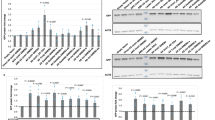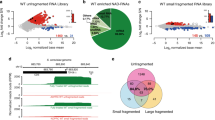Abstract—
Short Interspersed Elements (SINEs) are mobile genetic elements of higher eukaryotes, which originated during evolution from various tRNAs and less often from 5S rRNA and 7SL RNA. Similar to the genes of these RNAs, SINEs are transcribed by RNA polymerase III. The transcripts of some mammalian SINEs have an ability to undergo AAUAAA-dependent polyadenylation, which is unique for the RNA polymerase III transcripts. It is well known that this polyadenylation of many RNA polymerase II transcripts (e.g., mRNAs) increases their lifetime in the cell. The aim of this work is to examine whether the stability of SINE transcripts increases as a result of AAUAAA-dependent polyadenylation. HeLa cells were transfected with SINE DNA, both containing and not containing the polyadenylation signal (AATAAA). One day later, the transcription was inhibited by actinomycin D, and the decrease in the level of the SINE transcripts was monitored by northern hybridization. For all the eight studied SINEs, the half-life of nonpolyadenylated transcripts was 20–30 minutes, and for polyadenylated transcripts, this parameter exceeded 3 hours. Interestingly, the insertion of an additional 80-bp DNA fragment into the middle region of B2 SINE did not significantly reduce the stability of the polyadenylated transcripts. It is most likely that the increase in the lifetime of the polyadenylated SINE transcripts is due to the fact that the poly(A) tail interacts with the poly(A)-binding proteins (PABPs), thus protecting the RNA from degradation by the exonucleases acting from the 3'-end. The results make it possible to design SINE-based vectors intended for the expression of short noncoding RNAs, which are stable in a cell due to polyadenylation.





Similar content being viewed by others
REFERENCES
Schoenberg D.R., Maquat L.E. 2012. Regulation of cytoplasmic mRNA decay. Nat. Rev. Genet.13, 246–259.
Ntini E., Jarvelin A.I., Bornholdt J., Chen Y., Boyd M., Jorgensen M., Andersson R., Hoof I., Schein A., Andersen P.R., Andersen P.K., Preker P., Valen E., Zhao X., Pelechano V., et al. 2013. Polyadenylation site-induced decay of upstream transcripts enforces promoter directionality. Nat. Struct. Mol. Biol.20, 923–928.
Barreau C., Paillard L., Osborne H.B. 2005. AU-rich elements and associated factors: are there unifying principles? Nucleic Acids Res.33, 7138–7150.
Goodarzi H., Najafabadi H.S., Oikonomou P., Greco T.M., Fish L., Salavati R., Cristea I.M., Tavazoie S. 2012. Systematic discovery of structural elements governing stability of mammalian messenger RNAs. Nature.485, 264–268.
Rashid F., Shah A., Shan G. 2016. Long non-coding RNAs in the cytoplasm. Genomics Proteomics Bioinformatics.14, 73–80.
Iwakawa H.O., Tomari Y. 2015. The functions of microRNAs: mRNA decay and translational repression. Trends Cell Biol.25, 651–665.
Nagarajan V.K., Jones C.I., Newbury S.F., Green P.J. 2013. XRN 5'→3' exoribonucleases: Structure, mechanisms and functions. Biochim. Biophys. Acta.1829, 590–603.
Chlebowski A., Lubas M., Jensen T.H., Dziembowski A. 2013. RNA decay machines: The exosome. Biochim. Biophys. Acta.1829, 552–560.
Eckmann C.R., Rammelt C., Wahle E. 2011. Control of poly(A) tail length. Wiley Interdiscip. Rev. RNA.2, 348–361.
Proudfoot N.J. 2011. Ending the message: poly(A) signals then and now. Genes Dev.25, 1770–1782.
Zheng D., Ezzeddine N., Chen C.Y., Zhu W., He X., Shyu A.B. 2008. Deadenylation is prerequisite for P-body formation and mRNA decay in mammalian cells. J. Cell Biol.182, 89–101.
Ustyantsev I.G., Golubshikova Yu.S., Borodulina O.R., Kramerov D.A. 2017. Canonical and noncanonical RNA polyadenylation. Mol. Biol. (Moscow). 51 (2), 226–236.
Falk S., Weir J.R., Hentschel J., Reichelt P., Bonneau F., Conti E. 2014. The molecular architecture of the TRAMP complex reveals the organization and interplay of its two catalytic activities. Mol. Cell.55, 856–867.
Schmidt K., Butler J.S. 2013. Nuclear RNA surveillance: role of TRAMP in controlling exosome specificity. Wiley Interdiscip. Rev. RNA.4, 217–231.
Lubas M., Andersen P.R., Schein A., Dziembowski A., Kudla G., Jensen T.H. 2015. The human nuclear exosome targeting complex is loaded onto newly synthesized RNA to direct early ribonucleolysis. Cell. Rep.10, 178–192.
Kramerov D.A., Vassetzky N.S. 2011. SINEs. Wiley Interdiscip. Rev. RNA.2, 772–786.
Borodulina O.R., Kramerov D.A. 2001. Short interspersed elements (SINEs) from insectivores. Two classes of mammalian SINEs distinguished by A-rich tail structure. Mamm. Genome.12, 779–786.
Kramerov D.A., Tillib S.V., Shumyatsky G.P., Georgiev G.P. 1990. The most abundant nascent poly(A)+ RNAs are transcribed by RNA polymerase III in murine tumor cells. Nucleic Acids Res.18, 4499–4506.
Borodulina O.R., Kramerov D.A. 2008. Transcripts synthesized by RNA polymerase III can be polyadenylated in an AAUAAA-dependent manner. RNA.14, 1865–1873.
Borodulina O.R., Golubchikova J.S., Ustyantsev I.G., Kramerov D.A. 2016. Polyadenylation of RNA transcribed from mammalian SINEs by RNA polymerase III: complex requirements for nucleotide sequences. Biochim. Biophys. Acta.1859, 355–365.
Koval A.P., Gogolevskaya I.K., Tatosyan K.A., Kramerov D.A. 2015. A 5'-3' terminal stem in small non-coding RNAs extends their lifetime. Gene.555, 464–468.
Gogolevskaya I.K., Kramerov D.A. 2010. 4.5SI RNA genes and the role of their 5'-flanking sequences in the gene transcription. Gene.451, 32–37.
Chomczynski P., Sacchi N. 2006. The single-step method of RNA isolation by acid guanidinium thiocyanate-phenol-chloroform extraction: Twenty-something years on. Nat. Protoc.1, 581–585.
Koval A.P., Gogolevskaya I.K., Tatosyan K.A., Kra-merov D.A. 2012. Complementarity of end regions increases the lifetime of small RNAs in mammalian cells. PLoS One.7, e44157.
Goss D.J., Kleiman F.E. 2013. Poly(A) binding proteins: Are they all created equal? Wiley Interdiscip. Rev. RNA.4, 167–179.
FUNDING
The work was supported by grant nos. 18-34-00247 mol_а and 17-04-00686 from the Russian Foundation for Basic Research.
Author information
Authors and Affiliations
Corresponding author
Ethics declarations
COMPLIANCE WITH ETHICAL STANDARDS
Conflict of interests. The authors state that they have no conflict of interest.
Statement on the welfare of animals. This article does not contain any studies using animals as objects.
Statement of compliance with standards of research involving humans as subjects. This article does not contain any research involving human subjects.
Additional information
Translated by A. Levina
Abbreviations: PABP, poly(A)-binding protein; SINE, short interspersed DNA elements; t1/2, half-life time; SINE from mammalian genomes: Can, dog; Dip, large jerboa (Allactaga major); Tal, mole (Mogera robusta); Ere, horse; Ves, Daubenton’s bat (Myotis daubentonii); B2, house mouse; Rhin-1A and Rhin-1B, Greater horseshoe bat (Rhinolophus ferrumequinum); B2-ins80, B2 with an 80 bp insert.
Rights and permissions
About this article
Cite this article
Ustyantsev, I.G., Tatosyan, K.A., Stasenko, D.V. et al. Polyadenylation of Sine Transcripts Generated by RNA Polymerase III Dramatically Prolongs Their Lifetime in Cells. Mol Biol 54, 67–74 (2020). https://doi.org/10.1134/S0026893319040150
Received:
Revised:
Accepted:
Published:
Issue Date:
DOI: https://doi.org/10.1134/S0026893319040150




